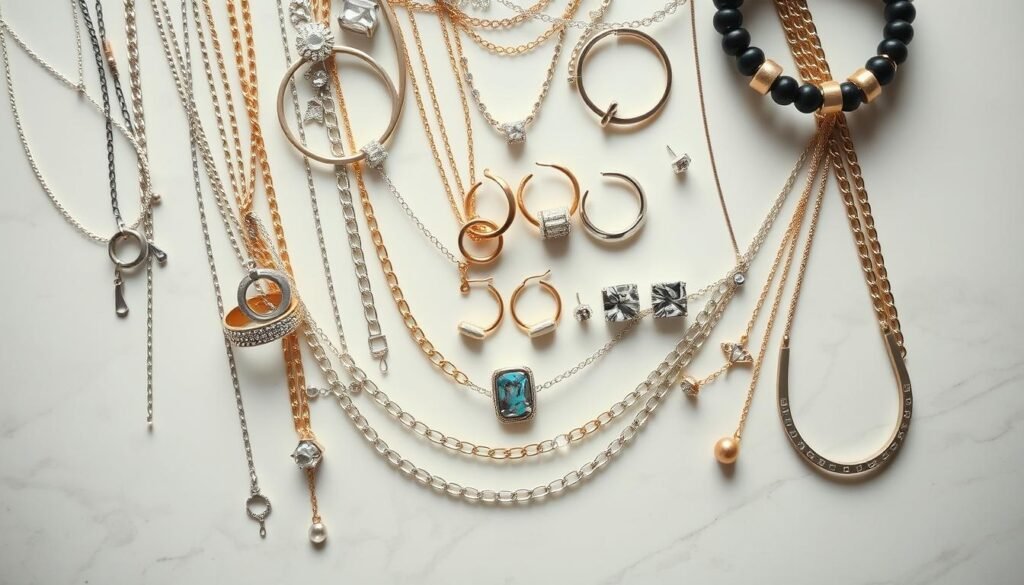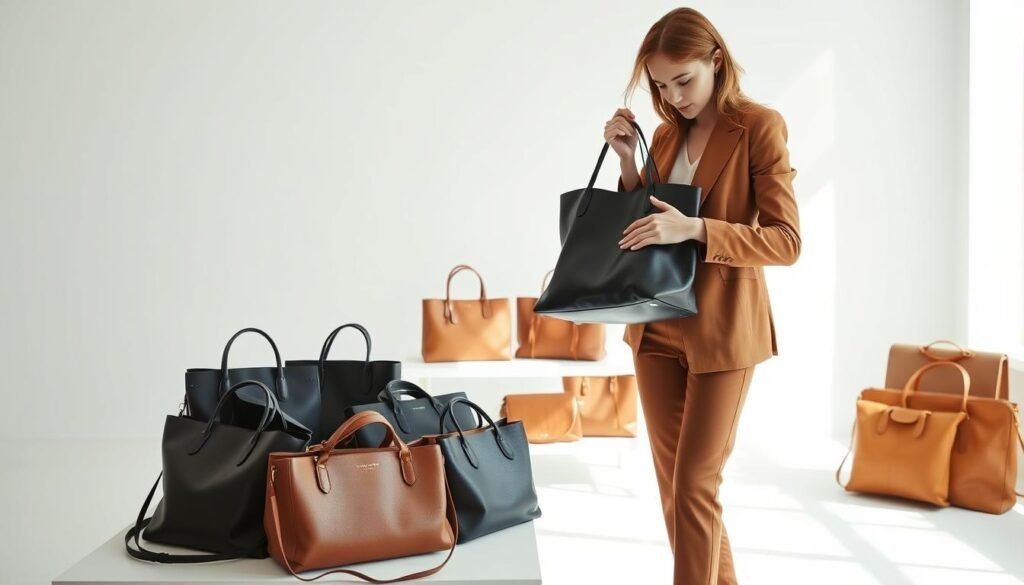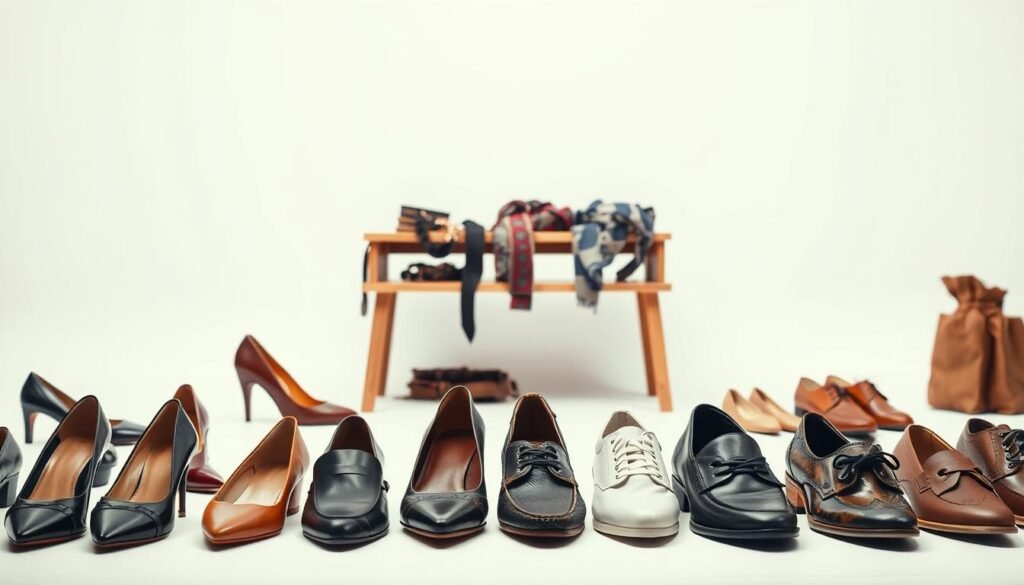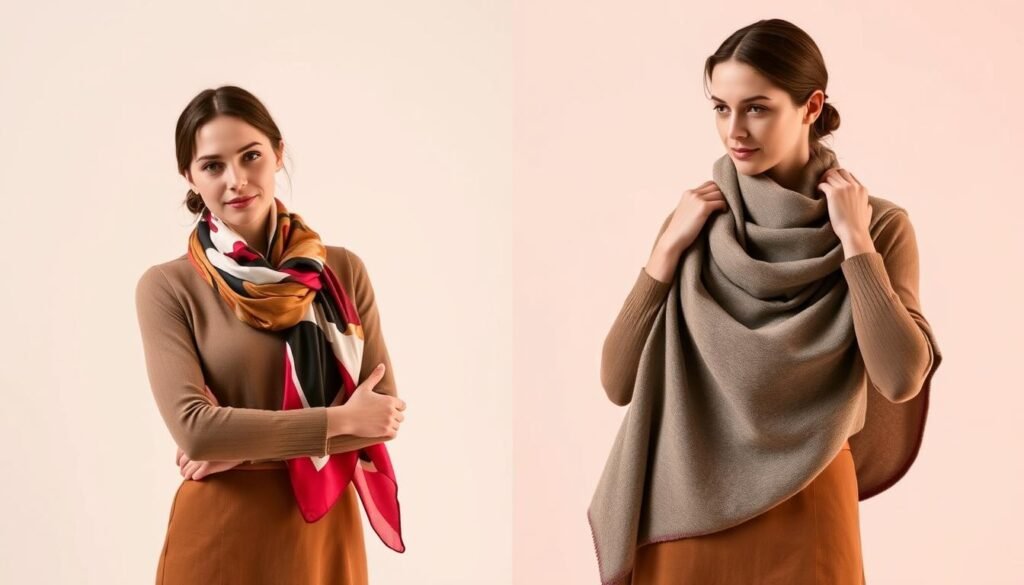“Fashion is what you buy. Style is what you do with it.” Diana Vreeland’s words highlight the essence of personal style. It’s not about the price of clothes, but how you make simple outfits stand out.
Fashion accessories are the key to changing your look. Think of Zendaya turning simple jeans into a red-carpet look with bold jewelry. Or Rihanna making a simple dress unforgettable with the right handbag and sunglasses.
These style icons know the secret. The right accessories don’t just finish an outfit—they turn it into a style transformation. Blake Lively shows this every time she steps out, using accessories to elevate casual looks.
You don’t need a new wardrobe to find your style. Accessories styling is a smart way to express yourself without spending a lot. Each piece tells your story and shows who you are.
Key Takeaways
- Accessories transform basic outfits into sophisticated, intentional looks
- Strategic styling choices can completely change your outfit’s impact and appeal
- Celebrity examples like Zendaya and Rihanna demonstrate effective accessory techniques
- Personal expression matters more than following every fashion trend
- Smart accessory choices offer affordable style upgrades without major wardrobe changes
- The right pieces serve as powerful tools for creating your signature style
Understanding the Transformative Power of Fashion Accessories

Fashion accessories have a big impact on how we look and feel. They change how we show ourselves to others. It’s more than just adding something to our clothes.
Accessories are key for personal branding and showing who we are. They tell our story without words.
Why Small Details Make the Biggest Impact
Our brains focus on patterns and key points. A bold necklace or scarf makes our outfit stand out. It creates a visual hierarchy.
Small touches add excitement to simple outfits. A black dress gets a boost from the right belt or earrings. These details bring balance and interest, making our outfits memorable.
The Science Behind Accessory Psychology
Style psychology shows how accessories boost our confidence. Wearing meaningful jewelry or favorite accessories makes us feel good. This makes us stand taller and feel more sure of ourselves.
Color therapy also affects our mood. Bright accessories energize us, while neutral tones calm us. Knowing this helps us pick accessories that match our mood.
Building Your Personal Style Foundation
Building a strong personal branding starts with knowing your lifestyle. Think about your daily life, work, and social events when picking accessories.
| Style Foundation Element | Key Accessories | Impact Level |
|---|---|---|
| Professional Polish | Classic watch, structured handbag | High |
| Casual Versatility | Crossbody bag, layered necklaces | Medium |
| Evening Elegance | Statement earrings, clutch | High |
Begin with pieces that fit many situations. Grow your collection slowly, focusing on quality for lasting style.
Essential Jewelry Pieces Every Wardrobe Needs

Choosing the right jewelry is key to a versatile wardrobe. It’s about picking pieces that go with many outfits and styles. These essentials are the foundation of any good jewelry collection.
Building a smart jewelry wardrobe means picking items that work for both work and play. Each piece should do more than one thing and show off your style.
Statement Necklaces and Layering Fundamentals
Statement pieces can make any outfit pop. The trick to jewelry layering is knowing about chain lengths and how they look together.
For V-necks, pick necklaces that hit just above the neckline. This makes your neck look longer and more elegant. With polonecks, go for longer necklaces to add interest without clashing with the high neckline.
Layering different chain weights and textures adds depth. Start with a thin chain near the neck, add a medium-length pendant, and end with a bold necklace. This creates a layered look that’s both sophisticated and interesting.
Versatile Earring Styles for Day to Night
Drop earrings are great with hair down, framing your face and adding movement. For work, stick with simple studs or small hoops that enhance your look without being too bold.
Turn a day look into a night look by switching to chandelier earrings or bold designs. These statement pieces make a big impact with just a little change.
Think about your face shape when picking earrings. Angular designs suit round faces, while curved or circular styles are best for square faces.
Bracelet and Ring Coordination Techniques
Now, it’s all about wearing rings on different fingers with different sizes and metals. This adds a personal touch without overwhelming your look.
Pair big, bold bracelets with delicate rings, or thin bangles with eye-catching cocktail rings. For work, go for classic watches and simple wedding bands or stackable rings.
Don’t be afraid to mix gold and silver metals. Just make sure each piece has its place. This modern take on accessories styling lets you create unique, personalized looks that show off your taste.
Mastering Handbag Selection and Pairing Strategies

Choosing the right handbag can make any outfit look great. Your bag is both useful and a style statement. Smart handbag styling means knowing which bag fits each occasion and outfit.
Start with four key handbags. You’ll need an over-the-shoulder bag for everyday, a backpack for work, a clutch for parties, and a briefcase or tote for other needs. This mix keeps your style consistent and you ready for anything.
Structured Bags for Professional Polish
Structured handbags make your work clothes look better with their neat lines and shapes. Pick a medium-sized bag that stays put when empty. Hardware details matter – go for gold or silver to match your jewelry.
The bag’s size should match your body and clothes. It should sit at your hip or a bit higher. Stick to colors like black, navy, or brown for a professional look that shows you’re put together.
Casual Crossbody and Tote Styling Rules
Crossbody bags are great for keeping your hands free and adding a casual touch. Make sure the strap fits right so the bag sits at your hip. Tote bags look best when they’re not too full to keep their shape.
Choose a bag that fits your body and needs. Smaller crossbodies are good for petite frames, while taller people can carry bigger totes. Neutral colors are best for casual outfits because they go with everything.
Evening Clutch Selection and Coordination
Evening clutches should enhance your formal look, not clash with it. Pick a size that holds what you need without being too big. Embellishment levels should match your outfit’s formality – simple clutches work well with fancy dresses.
Metallic clutches are versatile for evening wear. Think about your outfit’s neckline and jewelry when picking a clutch. Structured clutches go with flowing dresses, while soft pouches suit tailored looks.
Color Matching and Texture Contrast Methods
Good accessory coordination means choosing the right colors and textures. Match your bag to your shoes for a classic look, or pick colors that complement each other for a modern vibe. Neutral bags like black, brown, or beige match most of your clothes.
Texture contrast adds interest to your outfit. Mix smooth leather bags with textured clothes, or suede with sleek materials. Effective bag pairing balances color and texture to create outfits that show off your style.
Shoe Recommendations for Every Style Transformation

Shoes can change your look from casual to fancy in no time. The right pair can make jeans and a t-shirt look professional or turn a suit into a date-night outfit. Knowing how different shoes work with outfits lets you create many looks from the same clothes.
Choosing the right footwear styling can instantly improve your look without needing a new wardrobe. Each shoe style opens up new styling options. This lets you show different sides of yourself all week long.
Classic Pump Styling for Maximum Versatility
Classic pumps are the most versatile shoes for any wardrobe. A good pair in black or nude is perfect for work and dinner. Pointed-toe pumps add elegance to flared jeans or tailored pants.
Heels between two to four inches are best for comfort and style. Lower heels are great for long days, while higher ones add drama for nights out. Choose pumps that support your feet for all-day wear.
Elevated Sneaker Combinations for Modern Looks
Platform sneakers mix comfort with style, perfect for casual outfit transformation. They look great with midi skirts, cropped pants, and casual dresses for a modern look.
White leather sneakers are a neutral choice, while metallic or textured ones add flair. The key is to balance chunky sneakers with simple clothes.
Boot Options Across Seasons and Occasions
Ankle boots add a cool edge to dresses and skirts. In cold weather, knee-high boots make outfits sophisticated with sweater dresses or tucked-in tops. Brogues give a stylish, androgynous touch to casual outfits.
Think about heel height and shaft length for different body types. Shorter boots are good with cropped pants, while taller ones pair well with skinny jeans or leggings.
Strategic Flat Shoe Styling Techniques
Flat shoes show that you can be stylish and comfortable. Oxford shoes add polish to casual outfits, while ballet flats bring elegance to work and social events. Loafers give a preppy, put-together look for various occasions.
| Shoe Type | Best Occasions | Styling Impact | Key Features |
|---|---|---|---|
| Classic Pumps | Work, formal events, dates | Instant sophistication | Pointed toe, 2-4 inch heel |
| Platform Sneakers | Casual outings, weekend wear | Modern edge, height boost | Thick sole, contemporary design |
| Ankle Boots | Transitional seasons, casual-chic | Edgy sophistication | Versatile height, multiple textures |
| Oxford Flats | Professional, smart casual | Polished comfort | Lace-up design, structured shape |
“The right pair of shoes can make or break an outfit. They’re the foundation that everything else builds upon.”
Scarf and Wrap Styling Techniques That Actually Work

Scarves can turn simple outfits into stylish ones with just a little effort. They are the perfect accessory to add a touch of elegance. Whether you’re going to work or a casual brunch, the right way to wear a scarf can make a big difference.
Learning how to style scarves opens up many possibilities for your wardrobe. You can go from classic neck wraps to creative uses. These tips will help you get the most out of every scarf you own.
Five Essential Neck Scarf Tying Methods
The classic loop is great for beginners. Fold your scarf in half, wrap it around your neck, and pull the ends through the loop. It instantly adds polish to any outfit.
The French knot adds elegance to professional looks. Wrap the scarf around your neck once, then tie a loose knot. This asymmetrical look is perfect with blazers.
For a casual look, try the loose drape method. Let your scarf hang naturally around your neck. The shoulder wrap and belt loop methods add texture and interest.
Alternative Scarf Styling Beyond the Neck
Scarves can be more than just neck wear. Use them as hair accessories by weaving them into braids or as headbands. This adds color and patterns to your look.
Turn scarves into unique belts by threading them through your belt loops. Or tie them around your waist over dresses. You can also attach them to handbag handles for a stylish touch.
Seasonal Fabric Selection and Care Tips
Choosing the right scarf depends on the season. Lightweight silks and cotton blends are perfect for spring and summer. Cashmere and wool keep you warm in the cold months.
Proper care extends the life of your scarves. Store delicate fabrics flat or rolled to avoid creases. Always check the care label before washing. Professional cleaning is best for luxury materials like silk and cashmere.
“Scarves are the exclamation point of an outfit – they can make even the simplest look feel intentional and complete.”
Belt Styling Secrets for Instant Outfit Upgrades
Accessories like belts can totally change your look. They can make your waist look better, add interest, and draw attention. Today, belts are more than just something to hold up your pants. They can make your outfit look amazing.
To style belts right, you need to know about width, material, and where to put them. They can make your waist look great or just balance your look. This works for both casual and formal outfits.
Wide Belt Techniques for Shape Creation
Wide belts are great for making your waist look smaller. Wear them at your natural waist for the best effect. They look great with long dresses, big sweaters, and loose cardigans.
For work, wear a wide belt with a blazer or coat. It makes you look neat and put together. It’s easy to look good when you know how to wear a wide belt.
Thin Belt Styling for Subtle Definition
Thin belts are for those who like a little touch of elegance. They give a soft waist look without changing your whole outfit. They’re good with high-waisted pants or loose tops.
Thin belts are great for many places. They keep you looking neat at work or for a casual lunch.
Color and Material Coordination Guidelines
Choosing the right belt means matching it with your other stuff. Make sure the belt metal matches your jewelry. Black leather belts go well with big bags, and chain belts are perfect for small evening bags.
Think about texture when picking a belt. Leather belts are good with knit clothes, and woven belts add something special to solid colors. Make sure your belt doesn’t clash with your bag’s style and color.
Accessories Styling: The Complete Coordination System
Learning the complete coordination system for accessories can turn simple outfits into stylish ones. This method makes sure every piece fits well together. Stylists use it to create outfits that look great and don’t feel too much.
Understanding how different accessories work together is key to good fashion coordination. By using a structured system, you’ll feel more confident in your styling. You’ll create outfits that look like they were meant to be.
The Three-Piece Rule for Balanced Looks
The three-piece rule is a great way to get style balance in your outfits. It means picking three accessories that go well together. Choose one standout piece and two that support it.
For example, wear bold earrings with a delicate bracelet and a simple watch. The earrings are the star, and the other pieces add a nice touch. This way, your outfit looks complete and thoughtful.
“Accessories are like vitamins to fashion — as such, you should use them liberally as such.”
Mixing Metals and Textures Successfully
Mixing metals is now seen as a stylish choice, not a mistake. Modern fashion coordination loves the contrast of different finishes and textures. Start with a mix of 70% one metal and 30% another.
Adding different textures makes your accessories more interesting. Try mixing smooth leather with woven materials, or shiny metal with matte finishes. This adds depth and keeps your look from being too plain.
Creating Visual Hierarchy and Focal Points
Creating a visual hierarchy makes your outfit flow well. Start with your most eye-catching accessory as the main focus. Then, add smaller pieces to draw attention to other parts of your outfit.
Use the triangle principle to place accessories. This creates balance and highlights your best features. It makes your style balance look natural and not forced.
Body Type Considerations for Accessory Placement
Knowing your body shape helps you pick accessories that flatter it. Petite frames look good with smaller pieces, while taller figures can pull off bold accessories.
Placing accessories wisely can enhance your shape. Use belts to define your waist, choose necklace lengths that match your neckline, and pick handbag sizes that balance your look. Good accessories styling should highlight your best features while keeping everything in harmony.
Seasonal Accessory Planning and Organization Systems
Creating a well-organized accessory collection needs careful planning and smart storage. Effective seasonal styling boosts your wardrobe and keeps clutter away. It’s about knowing which accessories fit each season and how to store them right.
Organizing your fashion accessories saves time and money. You’ll make better choices when you can see what you have. Plus, it makes your favorite pieces last longer.
Spring and Summer Lightweight Essentials
Warm weather means you need light, versatile accessories. Wide-brimmed hats protect your skin and add style. Opt for neutral colors like beige, navy, or straw for easy mixing.
Light scarves in cotton or silk are perfect for air-conditioned spaces. Delicate jewelry is great for summer, avoiding heavy layers. Look for pieces that go from beach to dinner easily.
Fall and Winter Statement Piece Selection
Colder months need accessories that add warmth and style. Statement necklaces look great over sweaters and coats. Bold earrings brighten up winter outfits, even when hair is covered.
Textured accessories like cable-knit scarves and leather gloves add to winter looks. Pick rich colors that match your coats. These items should be substantial enough for bulkier clothes.
Storage Solutions for Accessory Longevity
Good accessory organization prevents damage and makes dressing easier. Use clear jewelry boxes with compartments to avoid tangles. Hang scarves on shower curtain rings for easy access.
Store handbags with tissue paper to keep their shape. Keep them in dust bags on shelves for visibility. Rotate seasonal pieces to avoid closet clutter.
Investment vs. Trend Piece Decision Making
Smart shoppers mix timeless investments with trendy pieces. Invest in classic pieces like quality belts, pearl earrings, and silk scarves. These are the core of your accessory collection.
Save on trendy items that might go out of style soon. Colorful earrings or novelty bags can update your look without spending a lot. Spend more on pieces you’ll wear often across seasons and occasions.
Avoiding Common Accessory Styling Pitfalls
Styling can easily go from stylish to overwhelming. Knowing common mistakes helps you avoid this. Making smart choices becomes easier when you recognize these signs.
Recognizing Over-Accessorizing Warning Signs
It’s easy to over-accessorize. The three-second rule is a quick check: if it takes more than three seconds to take in your look, you’ve gone too far.
Look out for signs of too many accessories. Too many statement pieces can be overwhelming. Jewelry that clinks, too many colors, or accessories that get in the way are all bad signs.
Use the mirror test to check your look. Step back and see what catches your eye first. If accessories are the main focus, it’s time to simplify.
Proportion and Scale Balance Techniques
Understanding your body’s proportions is key to good accessory balance. Tall people look great with big accessories, while small frames do better with delicate ones.
Match your accessories to your outfit’s style. Big jewelry is good for casual looks, but formal events need something more refined. This rule applies to shoes and bags too.
Occasion-Appropriate Styling Guidelines
What’s right for your accessories depends on the occasion. Work calls for subtle, while parties are for bold choices.
Think about the setting and lighting. Outdoor events need accessories that won’t get caught in the wind. Indoors, delicate pieces can shine.
Quick Recovery Methods for Styling Mistakes
Even pros make styling mistakes that need quick fixes. The best way is to remove accessories one by one until it feels right.
For big mistakes, swap out bold items for something simpler. Or move accessories to different spots on your body for better balance.
| Common Mistake | Warning Sign | Quick Fix | Prevention Method |
|---|---|---|---|
| Too many statement pieces | Competing focal points | Choose one standout item | Follow the one-statement rule |
| Wrong proportions | Accessories overpower frame | Scale down by 50% | Match size to body type |
| Inappropriate formality | Looks out of place | Swap for neutral pieces | Research dress codes |
| Color overload | Clashing combinations | Stick to two-color limit | Use color wheel basics |
Conclusion
Learning how to style accessories can open up a world of fashion possibilities. This guide has shown you how to create stylish outfits that show off your unique style. From the three-piece rule to matching bags with outfits, each step helps make your look better.
Your fashion journey starts with making smart choices. Begin with items that go well with many outfits. A classic belt, a bold necklace, or a neat handbag can turn simple clothes into chic looks. Remember, getting good at styling takes practice and trying new things.
The secret is to mix trendy items with timeless classics. Good accessories are investments in your wardrobe that last long and are versatile. Choose pieces that make you feel confident and true to yourself.
Building your accessory collection takes time. Start with key items that fit your daily life and then add special pieces. Pay attention to size, color, and texture as you get better at matching things.
Every outfit is a chance to show off your style through accessories. Whether you like simple elegance or big statements, the basics are the same. Trust your taste and use the rules you’ve learned. Your accessories should boost your natural style, not hide it.

